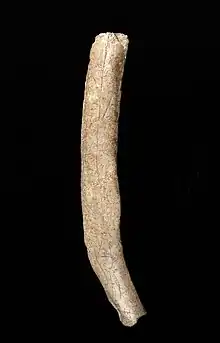
.jpg.webp)
The Pinhole Cave Man or Pin Hole Cave Man is the common name for an engraving of a human figure on a woolly rhinoceros rib bone dating to the Upper Paleolithic that is now in the British Museum (cataloged as Palart 854). In the 1920s, a woolly rhinoceros rib (Coelodonta antiquitatis) that was broken at both ends was found in Pin Hole Cave, Creswell Crags, Derbyshire, England.
Description
The bone is dated to the Late Upper Paleolithic, about 12,000 years old. Near one of the broken ends is engraved a male human figure. The drawing, 5 centimetres (2.0 in) tall, faces to the right; the whole bone is 20.8 centimetres (8.2 in) long. It is clearly a man as he has a penis – this may have been an earlier feature of the bone that was enhanced. His thin arm stretches out from his body. His head may be wearing a mask – or he is just drawn with a protruding nose and jaw. He has legs that appear incomplete, a crooked back, and a long engraved line across his upper body. The surface of the bone is scratched all over; on the reverse side of the bone there are two parallel engraved lines.[1]
Significance
This is one of only two pieces of British Upper Paleolithic portable art which shows a figure. The other is the Robin Hood Cave Horse, another image engraved on bone, found in the nearby Robin Hood Cave. It is similar to other pictures of male humans known from France at this period. The lack of clothes and the "cartoon" or "masked" heads are common features which suggest an artistic fashion. Like many human depictions in Palaeolithic art, the figure is crudely drawn; animals are typically better executed. This was not through a lack of ability, as animals are often represented with degrees of realism – see for example the Robin Hood Cave Horse. It may even be part of a more complex carving.[2]
Discovery
Pinhole Cave Man was discovered in 1928 by the archaeologist A. L. Armstrong, who described the engraving as "a masked human figure in the act of dancing a ceremonial dance".[3] The drawing was discovered after a stalagmitic film was removed from the bone's surface near the base of the Later Upper Palaeolithic lithic distribution.[4]
Exhibitions
Pinhole Cave Man has been shown in various places:[1]
- It was lent to the Cresswell Crags Museum from 2009 to 2011.
- It was included in the "Fantastic Creatures" exhibition held from January to April 2012 in the Hong Kong Museum of Art, and from June to September 2011 in the Ulsan Museum in South Korea.
- It was featured in the Ice Age Art exhibition at the Fundación Botín in Santander, Spain, in 2013.
See also
Notes
- 1 2 "Collection online". British Museum. Retrieved 21 October 2019.
- ↑ Jenkinson, R (2023). "A North-Western Habitat: the Paleoethology and Colonisation of a European Peninsula (a comprehensive analysis of excavations in Pin Hole Cave, Creswell Crags)". Internet Archaeology (61). doi:10.11141/ia.61.1.
- ↑ Armstrong 1928, p. 28
- ↑ Jenkinson, R (2023). "A North-Western Habitat: the Paleoethology and Colonisation of a European Peninsula (a comprehensive analysis of excavations in Pin Hole Cave, Creswell Crags)". Internet Archaeology (61). doi:10.11141/ia.61.1.
References
- Armstrong, A. L. 1928. "Pin Hole Cave excavations, Creswell Crags, Derbyshire: discovery of an engraved drawing of a masked human figure." Proceedings of the Prehistoric Society of East Anglia 6, 27–9.
- Bahn, P. 2007. "Historical background to the discovery of cave art". In P. Pettitt, P. Bahn and S. Ripoll (eds), Palaeolithic cave art at Creswell Crags in European context, 1–13. Oxford: Oxford University Press.
- "British Museum", "engraved bone/antler" on the British Museum online database
- Sieveking, A. 1987. A Catalogue of Palaeolithic art. London: The British Museum Press, as no. 854.